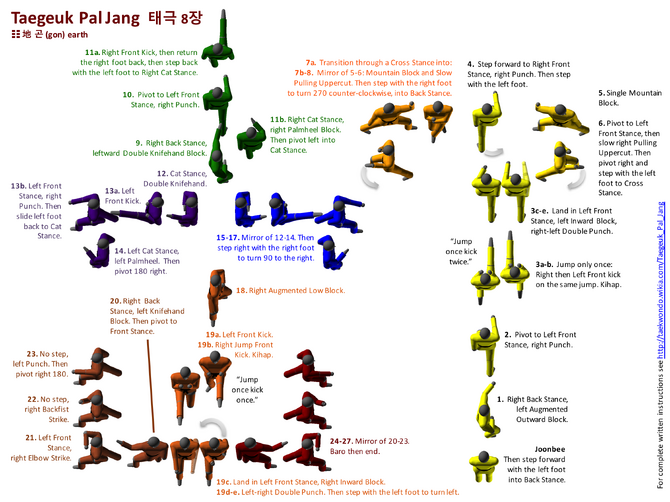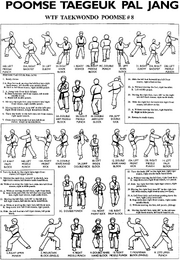
Taegeuk Pal Jang - alternative diagram
Taegeuk Pal Jang is the last of eight "taegeuk" forms (i.e., poomsae) used by the Kukkiwon and World Taekwondo (WT). The word "pal" is the number 8 in the sino-Korean numbering system.
Each taegeuk form is represented by a trigram (such as ☷); trigrams are divination symbols derived from the I Ching. The trigram for Taegeuk Sam Jang represents the concept of "Gon," meaning earth or ground. Just as the earth holds all the basic elements of life, this form incorporates all the basic techniques of taekwondo. Just as the earth is the foundation for everything else, this form serves as the foundation for learning the upcoming Black Belt forms. (See the article Taegeuk for additional detail regarding the symbolism of this form.)
1st Gup trainees practice this poomsae. After Taegeuk Pal Jang, students usually test for Black Belt and then begin to study the form Koryo.
Trivia:
- Taegeuk Pal Jang and Taegeuk Yook Jang are the only Taegeuk forms that don't end in a kihap. For Pal Jang this especially makes sense, as a kihap at the end would throw off the symmetry of the final line.
- Taegeuk Pal Jang is the only Taegeuk form where you start by transitioning forward all the way to the third line.
Video
The Kukkiwon official video for this form is on YouTube here.
Video with Notes
The following video is a step-by-step demonstration of Taegeuk Pal Jang, with notes.
Video from Behind
Often it's useful to watch a video that's viewed from behind the performer's starting position.
Diagram
To print the diagram, click on the image and select "See full size image," or right-click and open the image in a new tab.
New movements in this form: Augmented Outward Block (at Step 1), Mountain Block (at step 5), Jump Front Kick (at step 3a).
Written Instructions
Like all Taegeuk forms, this poomsae is performed on three lines. Imagine three parallel lines laid out side-to-side before you. You first perform the steps on the first line, then step forward to the second line, perform the steps on the second line, step forward to the third line, etc. The left side of each line is a mirror image of the right side of the line.
Taegeuk Pal Jang is interesting in that it runs "backwards." Instead of starting at the first line and finishing at the third line, it immediately steps to the third line and later returns to execute the first line.
BEGIN BY MOVING FORWARD TO THE THIRD LINE
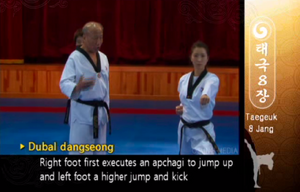
Double Jumping Front Kicks
- Start in the Ready position or "joon-bee" stance.
- 1. Step forward with left foot into right back stance (i.e., left foot forward). Leftward augmented outward block.
- 2. From the back stance position, slide the left foot forward and pivot into a left front stance. Right middle punch.
- 3a-b. Double jumping front kick: jump into the air once, but kick twice while in the air: right leg then left leg. Kihap.
- Note that this is different from step 19a-b, in which you kick on one leg, then jump and kick with the other leg. In other words, these pairs of kicks are not symmetric with one another.
- 3c. Land in a left front stance. Left inward block.
- 3d. Without stepping, double punch (right hand first, then left hand).
- 4. Step forward into right front stance. Right middle punch.
- Chamber the right fist to the left waist in preparation for the upcoming single mountain block. Chamber the left fist to the right shoulder in preparation for the upcoming low block.
THIRD LINE
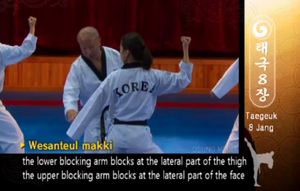
Single Mountain Block
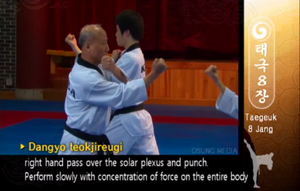
The pulling hand extends straight out in front of you, as if to grab the opponent's shoulder. Then pull the opponent into the slow uppercut.
- FIRST GOING RIGHT (Ra 3)...
- 5. Step back with the left foot to turn left 270 degrees into a modified front stance: the feet are not precisely in a front stance position; both feet are parallel with one another, but are turned slightly to the left. The left knee is straight and the right leg is bent (like a front stance). Left low block and right single mountain block (at same time), looking back toward the direction of the low block.
- 6. Briskly pivot your body into a proper left front stance. Aim the left arm in front of you; chamber the right fist (palm down) at the side of your chest (so your right fist is below your right arm-pit, elbow pointed straight back). Grab the opponent's shoulder with left hand and slowly pull it towards your right shoulder, simulaneously performing a slow right pulling uppercut to opponent's chin (this should be done to an 8-count).
- THEN GOING LEFT (Da 3)...
- 7a. Rapidly double step to the right, pivoting clockwise through a cross stance (left leg forward) and turning your head 180 degrees to look in the Da direction, so that you're in a position to begin repeating the above two steps, but now in the opposite direction. Once again you'll be in a modified front stance, this time with the left leg bent and the right leg straight. Both feet are parallel but turned slightly to the right.
- 7b. As before, right low block and left single mountain block (at same time), looking back toward the direction of the low block.
- 8. Briskly pivot into right front stance. As before, grab opponent's shoulder with right hand and pull towards your left shoulder, simulaneously slow left pulling uppercut to opponent's chin (done to an 8-count).
- TRANSITIONING TO THE SECOND LINE...
- 9. Step with the right foot to turn left 270 degrees into a right back stance (i.e., left foot forward). Leftward double knifehand block.
- Some schools chamber for the double knifehand block at the end of step 8 by placing the left knifehand at the right waist (palm up) with the right knifehand aimed out in front of you (or even pointing a bit to the left). This is done before the 270 degree turn that starts step 9.
- Other school start the turn first, and then as the turn is concluding perform a more conventional chamber for the double knifehand block: left knifehand at the right waist, right knifehand pointed out to the right side of the body.
- 10. Slide the left foot forward into left front stance. Right middle punch.
- 11a. Right front kick, then return the foot back behind the left foot when done.
- 11b. Step back with left foot, then bring the right foot back into a tiger stance (left foot forward). Right palmheel block.
- In other words, from step 11a-11b it will feel like you're taking two small steps backward: the right foot kicks, steps down and back; the left foot steps back, then the right foot steps back so that you're in a left-foot-forward tiger stance.
- 9. Step with the right foot to turn left 270 degrees into a right back stance (i.e., left foot forward). Leftward double knifehand block.
SECOND LINE
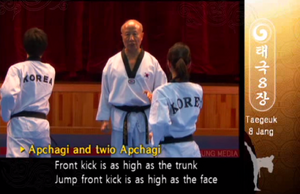
The second of two Double Front Kicks: left kick then jumping right kick
- FIRST GOING LEFT (Da 2)...
- 12. Step left with the left foot to turn left 90 degrees into tiger stance (left foot forward again). Leftward double knifehand block. Note that because you are facing fully forward in a tiger stance (as opposed to facing partially sideways as in a back stance), the double knifehand block seen here looks a bit different than the double knifehand block seen in back stances: the augmenting hand is still held palm-up in front of the chest but the blocking arm is out in front of your body (rather than out to the side of your body).
- 13a. Left front kick.
- 13b. Step down into in a left front stance. Right middle punch.
- 14. Move the left foot back half a step into tiger stance (still left foot forward). Left palmheel block.
- THEN GOING RIGHT (Ra 2)...
- 15. Pivot right 180 degrees into tiger stance (right foot forward). Rightward double knifehand block. Again, note that this double knifehand block in a tiger stance, which is slightly different than the same block down when seen in a back stance.
- 16a. Right front kick.
- 16b. Step down into in a right front stance. Left middle punch.
- 17. Move the right foot back half a step into tiger stance (still right foot forward). Right palmheel block.
- TRANSITION TO THE FIRST LINE...
- 18. Step right with the right foot to turn right 90 degrees to the right into a left back stance (right foot forward). Right augmented low block.
- 19a-b. Two front kicks: left kick then jumping right kick. Kihap. Note that this is somewhat different than the double kick seen in step 3a-b: in that case, the kick really was a double jump front kick. In this case, this is two distinct kicks: first a non-jumping left kick then a jumping right kick.
- 19c. Land in a right front stance. Right inward block.
- 19d-e. Double punch (left hand first, then right).
FIRST LINE
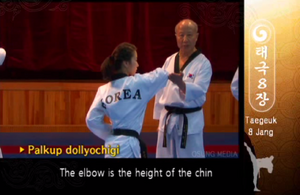
Unlike previous forms in the Taegeuk series, the Elbow Strike here is not performed with an assisting hand.
- FIRST GOING LEFT (Da 1)...
- 20. Step back with the left foot to turn left 270 degrees into a right back stance (left foot forward). Left knifehand outward block.
- 21. Slide the left foot forward into left front stance. Right elbow strike.
- 22. Without stepping, right backfist strike.
- 23. Without stepping, left middle punch.
- THEN GOING RIGHT (Ra 1)...
- 24. Pivot 180 degrees to the right into a left back stance (i.e., right foot forward). Right knifehand outward block.
- 25. Slide the right foot forward into right front stance. Left elbow strike.
- 26. Without stepping, left backfist strike.
- 27. Without stepping, right middle punch.
- When Master yells "bah-ro", move left foot, turn left 90 degrees and return to Ready stance. As usual, if you did everything correctly, you should wind up where you started.
Wallpapers
To save this image, click on the image and select "See full size image" -- or right-click and open the image in a new tab. Then right-click on the full-size image to save it to your desktop.
Other Forms in the Taegeuk Series
- Taegeuk Il Jang also called Taegeuk 1 Jang
- Taegeuk Yi Jang also spelled Taegeuk Ee Jang, or Taegeuk 2 Jang
- Taegeuk Sam Jang also spelled Taegeuk Sahm Jang, or Taegeuk 3 Jang
- Taegeuk Sa Jang also spelled Taegeuk Sah Jang, or Taegeuk 4 Jang
- Taegeuk Oh Jang also spelled Taegeuk O Jang, or Taegeuk 5 Jang
- Taegeuk Yook Jang also spelled Taegeuk Yuk Jang, or Taegeuk 6 Jang
- Taegeuk Chil Jang also called Taegeuk 7 Jang
- Taegeuk Pal Jang also spelled Taegeuk Phal Jang, or Taegeuk 8 Jang
See Also
- Poomsae webpage at World Taekwondo Federation (WTF)
- Poomsae webpage at Kukkiwon, the WTF headquarters
- Grand Master Kyu Hyung Lee demonstrating Taegeuk Il Jang on YouTube
- List of Taekwondo techniques at Wikipedia
- Taegeuk Chil Jang on Taekwondo Animals
- Taegeuk Chil Jang at Taekwondo Preschool
- Taegeuk Chil Jang on Black Belt Wiki
- Taegeuk Chil Jang on Poomse.me
- Taegeuk Chil Jang on Taekwondo Bible, a Korean-developed website



